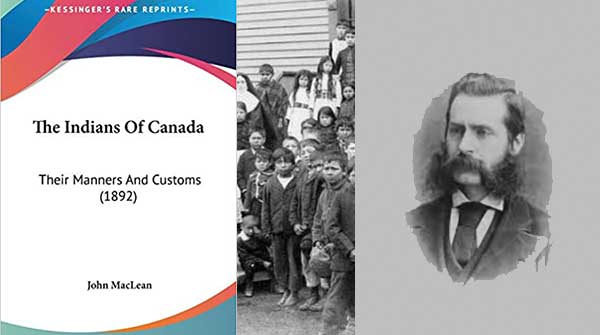An eye-opening description of Aboriginal culture as it was in the 1880s
 John McLean was a Christian missionary who lived for nine years with the Blood (Kainai) Indians in present-day Southern Alberta, learning their language, customs and traditions.
John McLean was a Christian missionary who lived for nine years with the Blood (Kainai) Indians in present-day Southern Alberta, learning their language, customs and traditions.
In 1889, at the request of the Smithsonian Institution, he wrote The Indians of Canada, a balanced account of Aboriginal culture, then tragically on the wane due to the extinction of the buffalo and the influx of Euro-Canadian immigrants.
His book shows the false nature of the accusations of today’s Aboriginal leaders that 19th-century Canadian leaders thought that Aboriginals were inferior “savages” and who wanted to “kill” their culture. It also illustrates that accurate knowledge and understanding of events from the past can be better attained through written, contemporaneous accounts.
McLean was an erudite, progressive Christian whose profound regard for and knowledge of Aboriginal culture permeates his book. For example, he writes: “Due credit must be given to the Indians for the intelligence, experience and sagacity displayed in all that belongs peculiarly to the native civilization … Underlying the blanket of the red man beats a noble heart, that shows true affection for his own kin, can be moved deeply by a brave action, and is true to the principles of honour, justice and truth.”
McLean’s book is an eye-opening description of Aboriginal culture as it was in the 1880s. The reader learns that the government did not discourage the ceremonial, lavish, gift-giving potlatch (called “give-aways” in Blackfoot) to suppress Aboriginal culture. Rather, the intention was to prevent Aboriginals from deliberately self-impoverishing themselves where, given the economic collapse of their old ways of life, it was no longer possible to replenish what was given away. The reader learns of the high incidence of blindness amongst ancient Aboriginals, “arising from the smoke of the lodges, uncleanness, the habitual use of paint, and hereditary diseases.”
McLean was often unsparing in his criticisms of many aspects of Aboriginal culture. For example, he writes of the brutal and callous mistreatment of women, who were traded, bought, and sold for horses:
Amongst the Blackfeet, marriage is simply a bargain between the suitor and the young woman’s father for a certain number of horses …. In the good old days when the buffalo were abundant, the more wives a man possessed, the richer he became …. When the husband became angry with the wife he beat her with impunity; when he wished her no longer he sold her, and when she was found guilty of adultery, her nose was cut off.
He describes, in painful detail, Aboriginal practices of constant war-making, human sacrifice, scalping, slavery, ritual torture, blood-drinking, banishment, cannibalism, polygamy, kidnapping, and forced adoption. Clearly, they were as much migrators and conquerors amongst themselves as present-day Aboriginals accuse Euro-Canadians of being towards them.
The fact that none of these practices would be countenanced by Aboriginals (or non-Aboriginals) today shows just how irrevocably lost genuine pre-contact Aboriginal cultures have become; lost to and overwhelmed by the irresistible advantages of Euro-Canadian culture, including in the case of women, all the advantages of being protected by the rule of law against the type of mistreatment described above.
The tragic end of Aboriginal culture in the late 19th century gave rise to the compelling and urgent need to establish schools for Aboriginal youth in order to provide them with the kind of education they would need to help them integrate into the new world that was engulfing them. Thus, residential schools were established, not to rob a people of their culture, as falsely asserted, but to save and give new hope to a people whose old culture had already been irretrievably lost.
John McLean was an incurable Christian optimist. He believed, along with a number of Aboriginal leaders such as George Copway, Dr. Peter Jones, and Joseph Brant, that humanity was progressing steadily up an evolutionary ladder, where, at the top, it would find its destiny as a unified, racially integrated, pluralistic whole. This was his vision for Canada. I believe that he assumed that the Indian reserves set aside by the treaties in his era were only temporary waystations on the path to racial integration and full equality for all Canadians.
Now, over 130 years after John McLean’s neglected call for Canada to travel the path of becoming a unified cultural whole, we can properly regard the establishment of reserves as a great mistake. Because of this policy, Aboriginal Canadians are at the bottom of every indicator of social and economic success.
Hardly anyone has the fortitude to say what John McLean was saying in the 1880s. This great mistake of assigning Aboriginal Canadians to reserves should be corrected by changing our laws carefully and compassionately and phasing out this apartheid system. This would realize John McLean’s vision. There are countless lives of both Aboriginals and non-Aboriginals in the balance.
Peter Best is a retired lawyer who lives in Sudbury, Ontario. He is the author of There Is No Difference – An Argument for the Abolition of the Reserve System, endorsed by retired Supreme Court of Canada Justice Jack Major.
For interview requests, click here.
The opinions expressed by our columnists and contributors are theirs alone and do not inherently or expressly reflect the views of our publication.
© Troy Media
Troy Media is an editorial content provider to media outlets and its own hosted community news outlets across Canada.


